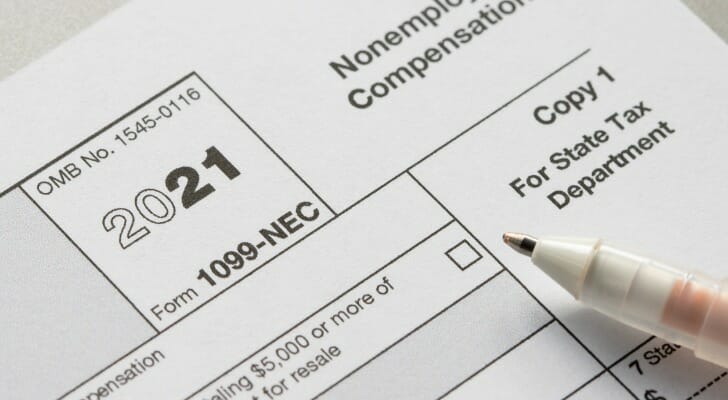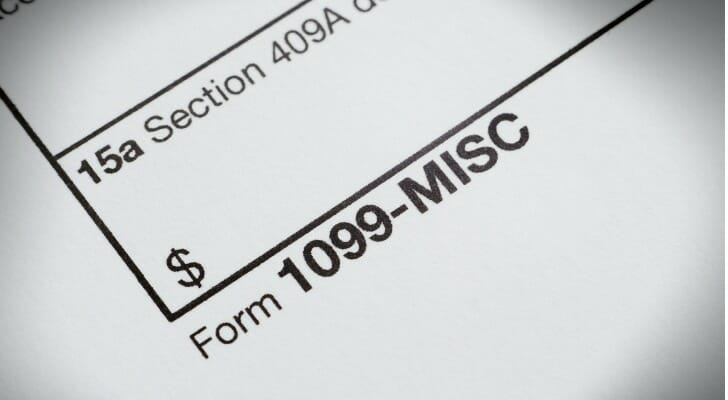Whether you’re a business owner who relies on independent contractors or you make your living as a freelancer, understanding the difference between Form 1099-MISC and 1099-NEC is critical to ensuring tax season runs smoothly. While Form 1099-MISC is used to report payments that aren’t subject to self-employment tax, 1099-NEC reports non-employee compensation. A financial advisor may be able to help optimize your tax strategy as part of a comprehensive financial plan.
What Is Form 1099-MISC?
IRS Form 1099-MISC is the tax form businesses use to report miscellaneous payments that are not subject to self-employment tax, including rent, prizes, awards, as well as medical and health care payments. You’ll need to use this form to report any miscellaneous payments of at least $600 made to a business or individual. The IRS has a complete list of these qualifying payments on its website.
You can file Form 1099-MISC either by paper or electronically. The IRS says the form must be filed on or before Feb. 28 if you file by paper. If you file electronically, the deadline is March 31.
What Is Form 1099-NEC?
Businesses use IRS Form 1099-NEC to report $600 or more in non-employee compensation (NEC). Generally, these contractor payments go to a person who is subject to self-employment tax. The IRS says this means either payments for services to someone who is not your employee or payments to an attorney. Specifically, these could include payments to a freelance graphic designer or a writer who completes a project or assignment.
Prior to 2020, this kind of payment was reported on Form 1099-MISC. However, the IRS revised its forms in 2020 and separated payments to self-employed contractors on its own form, which became Form 1099-NEC.
How to File Form 1099-NEC
When filing Form 1099-NEC, there will be a Copy A and a Copy B. Copy A is only for informational purposes and should not be printed and filed, according to the IRS. Only Copy B should be printed (if desired) and filed. Copy B can be sent to the contractor for their records, but it is the responsibility of the one making the payments to fill out and file Copy B.
Form 1099-NEC only has one filing deadline, which is Jan. 31. If you’re a freelancer or independent contractor, you should receive your 1099-NEC by this date. Unlike Form 1099-MISC, there are no separate deadlines when filing by paper or electronically.
Required Information on Form 1099-MISC and Form 1099-NEC
When filling out Form 1099-MISC and Form 1099-NEC, make sure you have the right information for both you and the one who received the payment. You can find relevant information on the employee’s W-9. Businesses are required to collect this from each independent contractor with whom they work, so you might already have it on hand.
Once you have the necessary information, be sure to fill in the following on Form 1099-MISC and Form 1099-NEC:
- Payee’s name: The form must include the payee’s name. This could be the name of the individual or a business.
- Payee type: Here is where you will indicate whether the payee is a person, a business, a corporation, etc.
- Address: Here, you will include the payee’s mailing address.
- Tax ID: If applicable, include the payee’s taxpayer identification number.
Who Needs to File Form 1099?
Form 1099, whether it’s 1099-MISC or 1099-NEC, is not required in all situations. But if you have made $600 or more in miscellaneous payments or payments to contractors, you’ll need to take the following steps:
- Make a qualifying reimbursement. For example, you might have paid $600 or more to a contractor during the year, or maybe you paid rent.
- Collect Form W-9. Any time you establish a relationship with an independent contractor, you should collect Form W-9 from them.
- Complete Form 1099-MISC or Form 1099-NEC. As tax time approaches, be sure to fill out the relevant forms as needed. Remember to file before the deadline.
- Submit tax documents. Once you have properly documented any miscellaneous payments or payments to contractors, you are ready to file your own tax documents.
Bottom Line
Form 1099-MISC and Form 1099-NEC are similar in many ways. The biggest difference is whether you are reporting payments to a contractor or miscellaneous payments. They were once just one form, but the IRS decided to separate the two in 2020.
Now, Form 1099-MISC includes miscellaneous payments like rent and legal settlements. Meanwhile, Form 1099-NEC records payments to entities like independent contractors and freelancers who pay self-employment tax. While the forms are similar, both are important to file by the deadline if you paid more than $600 during the year.
Tips for Tax Filing
- A financial advisor can help optimize your tax strategy for your financial goals. Finding a financial advisor doesn’t have to be hard. SmartAsset’s free tool matches you with up to three vetted financial advisors who serve your area, and you can have a free introductory call with your advisor matches to decide which one you feel is right for you. If you’re ready to find an advisor who can help you achieve your financial goals, get started now.
- When the tax code changes, it’s a good idea to use a good tax filing service. We did our annual roundup of the best tax filing software so that you can get through this tax season as painlessly as possible.
- If you want to see whether you’ll get a tax refund or have to pay a tax bill, SmartAsset’s tax return calculator can help you plan ahead.
Photo credit: ©iStock.com/MStudioImages, ©iStock.com/hapabapa, ©iStock.com/TheCrimsonRibbon


